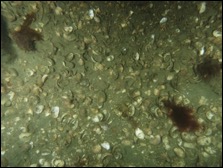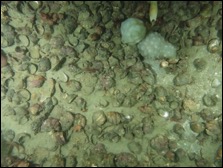The cruise ‘Pagure-Next’ (on R/V Thalia) was held in the Bay of Brest from 20th to 25th April 2018 to investigate with underwater imagery the ecological state of soft bottoms colonized by the slipper limpet (Crepidula fornicata), an emblematic invasive gastropod. This kind of perturbation can affect the ecosystem structure and functioning, negatively or positively, depending of the users’ point of view (scientists, fishermen, etc.) and on the spatial scale at which this interaction is analysed (local vs. embayment).
We used for this purpose the new underwater video system ‘Pagure-2’, developed in 2016 in the frame of the EU project JERICO-Next (WP3). ‘Pagure-2’ was deployed successfully during 5 days in a sledge mode (it can also be deployed in a ‘flying’ mode when necessary) and has collected about 8 hours of video footage and 2500 high resolution photos of the benthic biodiversity (mega- and macro-epifauna).
30 video profiles (on average 500m long) were achieved on shallow muddy habitats more or less intensively colonized by C. fornicata, as well as on neighbouring areas without C. Crepidula (considered as reference) in order to assess how the epibenthic compartment is modified by the proliferation of the slipper limpet.
Since C. fornicata has started to significantly decline in the Bay of Brest in the 2000’s, forming large beds of empty shells, we also investigate the impact of this recent evolution on benthic biodiversity.
Preliminary interpretations of images showed that several species of large suspension-feeders (e.g., variegated scallop, flat European oyster, ascidians) thrive in dense living Crepidula beds of the northern part of the Bay. Conversely, very few megafauna was detected on dead Crepidula beds, which now occur in the southern part of the Bay.
Preliminary interpretations of images showed that several species of large suspension-feeders (e.g., variegated scallop, flat European oyster, ascidians) thrive in dense living Crepidula beds of the northern part of the Bay. Conversely, very few megafauna was detected on dead Crepidula beds, which now occur in the southern part of the Bay.


